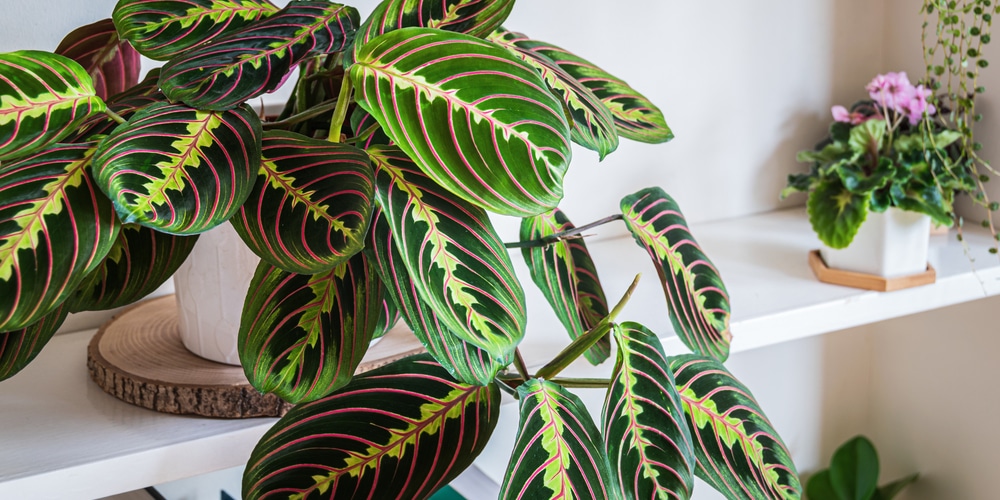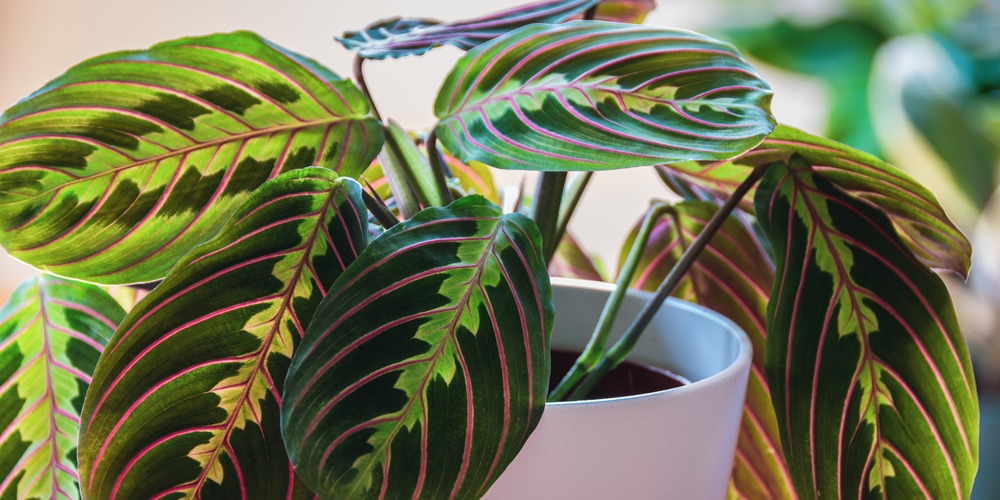Prayer plants look great and make a lovely addition to any home. They are a popular houseplant with a tropical look and lovely green and pink leaves. These plants originate from the jungles of Brazil, where they bloom annually with beautiful flowers. Unfortunately, prayer plants that are grown indoors are unlikely to flower. If you are having trouble with your prayer plant, we’ll help you revive it.
Prayer plants get their name due to the folding nature of their leaves. At night the leaves fold in half and resemble hands held together in prayer. These plants are relatively easy to care for, can thrive in homes with low light, and grow up to 12 inches tall.
Prayer plants need to be cared for correctly as incorrect watering or humidity levels can cause them to wilt. If you have a prayer plant that’s looking worse for wear, read on. In this article, we’ll discuss how to revive a prayer plant.
What causes a Prayer Plant to wilt?

Prayer plants will begin to wilt if they aren’t receiving the correct care. While you may have tried praying for your plant or even giving it holy water, there are more effective ways to revive your prayer plant. The prayer plant’s leaves wilt, and the plant will eventually die due to incorrect watering, pests, low humidity, or being placed in direct sunlight.
Incorrect Watering
One of the main causes of wilting is due to underwatering. Prayer plants require more water during the hot summer months than they do in the winter. An underwatered prayer plant can be revived by giving it a good soaking and then leaving the soil to dry out before watering again. You can test your plant’s soil by putting your finger about two inches into the soil. If the soil feels bone dry, underwatering is likely the cause of your plant’s distress.
Some people overwater their prayer plants which can also be an issue. Too much water can cause your plant’s roots to rot. This will cause the plant to wilt and eventually die. You should plant your prayer plant in a pot that has drainage holes in the bottom. You may also like to add a layer of gravel at the bottom of the pot to help with drainage. This will also help by aerating the soil.
It’s best to water your prayer plant first thing in the morning, as this reduces the chance of your plant becoming waterlogged and suffering from root rot. Your plant will have the whole day to absorb the water, and any excess will evaporate. Providing your plant with a liquid fertilizer that can be added to the water every two weeks will help revive your plant. Continue to provide fertilizer even after your plant has recovered to help it grow strong and healthy. A good quality house plant fertilizer will allow your plant to thrive and make its leaves lovely and shiny.
Too Much Direct Sunlight
While prayer plants are a tropical species that likes the sun and grows well on a sunny windowsill, they should not be left in direct sunlight for too long. Prayer plants are relatively small and, in the wild, would be shaded by other larger plants. Don’t leave your prayer plant in direct sun for hours at a time, or it will dry out and begin to wilt. It’s recommended that you place your plant in indirect sunlight.
If you notice that the edges of your plant’s leaves are curling and turning brown, this is an indication of too much sun. You can either move your plant or place a shade above it.
Low Humidity
Pray plants require high humidity, but people often place their tropical plants near a heater to keep them warm. This actually lowers the humidity and can affect the health of your plant. While prayer-plants are a tropical variety, its humidity, rather than heat that’s more important to them. Low humidity can cause a prayer plant to wilt.
You can increase the humidity for your prayer plant by regularly spraying the plant with water to add moisture to the air. Don’t soak your plant as this could cause it to rot, a fine mist is all you need. Alternatively, grow a few tropical plants close together or put a tray underneath your plant with pebbles and stones. The plant will receive moisture as the water evaporates. You can also buy a humidity meter to test the humidity of the air. A humidifier will also help to increase the humidity around your plant.
Pests
One of the most common reasons that prayer plants wilt is due to insect pests. Insects such as aphids, mealybugs, and spider mites all attack prayer plants. These insects will suck sap from the plant’s foliage, leaving them looking unhealthy. Some insects also leave honeydew on plants, and this can cause sooty mold to develop. The best way to get rid of insect pests is to apply neem oil or insecticidal soap to your plant.
Prayer Plant Care Tips
Aim to take good care of your prayer plant to help it stay healthy and thrive. The right watering and fertilizer will improve your plant’s health and help it avoid wilting in the future. Here are some other ways you can care for your plant:
Dust Your Prayer Plants Foliage
Dust your prayer plant every couple of weeks to keep it looking its best. You can wipe your plant’s leaves with a damp cloth. This will not only improve the appearance of your plant but will also help with hydration.
Keep Your Plant Away from Drafts
Avoid leaving your prayer plant on a windowsill during the winter months. Your plant may start to wither and turn brown due to drafts. It’s best to place your plant somewhere a bit warmer, but you should avoid placing it too close to heaters as this could reduce the humidity available to your plant.
Pruning
To keep your plant in top condition and encourage new growth, you can prune twice annually. Cut off any dead leaves and thin out overcrowded areas to make your plant look more attractive.
Conclusion
Prayer plants have lovely foliage and are a popular houseplant worldwide. They are tropical plants that need to be cared for correctly. Incorrect conditions or care can result in wilting, and eventually, your plant could dye.
You can still revive your prayer plant. Ensure that your plants are watered correctly, don’t have any pests, and are placed in an area away from draughts where they can get plenty of sunlight.
